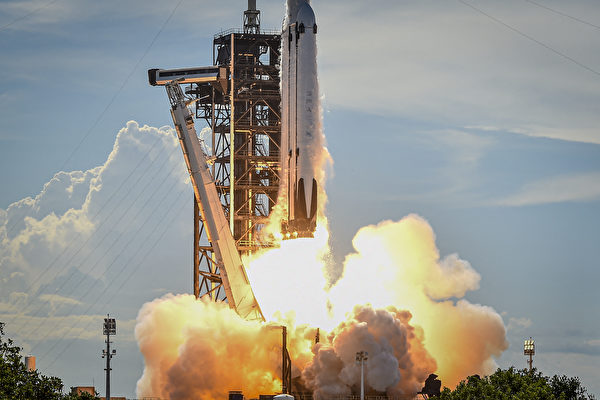【Epoch Times June 26, 2024】The powerful Falcon Heavy rocket from the American space exploration technology company SpaceX soared into the sky on Tuesday, June 25, launching a new US satellite into orbit. This satellite is expected to significantly improve meteorologists’ predictions of solar flares and coronal mass ejections, thereby reducing the potential adverse effects of geomagnetic storms.
According to the live stream online, this world’s most powerful operational rocket is composed of three modified Falcon cores and lifted off from the Kennedy Space Center in Florida at 5:26 pm local time on Tuesday, delivering the satellite into orbit.
SpaceX stated that the satellite named GOES-U was successfully deployed around 10 pm New York time. Positioned at an orbit height of approximately 22,200 miles (about 35,700 kilometers), this satellite will employ a compact coronagraph to aid meteorologists in monitoring solar storms, tracking hurricanes and lightning, conducting atmospheric measurements, and capturing images of the Earth.
Solar storms can emit dazzling lights. The largest solar storm event in 20 years in May not only led to auroras in areas where they had never been seen before but also caused widespread radio disruptions across the Americas.
GOES-U, which stands for Geostationary Operational Environmental Satellite U, is the fourth in a series of satellites jointly launched by the National Oceanic and Atmospheric Administration (NOAA), the National Oceanic and Atmospheric Administration, and NASA, and also the final one. Once in orbit, it will be renamed GOES-19, replacing the first satellite in this series launched in 2016, GOES-16, and working in tandem with GOES-18. Meanwhile, the GOES-16 satellite will serve as an on-orbit backup for the system to mitigate any potential satellite failures.
GOES-18 and GOES-19 satellites will collectively collect atmospheric, solar, climate, and oceanic data, covering a significant portion of the Earth from the west coast of Africa to New Zealand.
The distinct feature of GOES-U compared to other satellites is its coronagraph, which provides a new capability to closely monitor space weather.
NOAA National Weather Service director Ken Graham stated during a press conference on Monday that the GOES satellite series has “changed our game.”
“Since the first series of satellites was launched in 2016, the latest generation of GOES has brought improved forecasting and warning services to help save lives and protect property.”
As the sun approaches its solar maximum phase (expected to reach its peak in its 11-year cycle this year), its activity is becoming more active. Researchers observe increasingly intense solar flares and coronal mass ejections erupting from the sun’s surface.
When these eruptions align with Earth, they can trigger geomagnetic storms, disrupting the Earth’s magnetic field significantly. In such situations, communications, power grids, navigation systems, radios, and satellite operations are all susceptible to disturbances.
The multitude of instruments carried by GOES-U will enhance human detection of space weather disasters, including the compact coronagraph-1, which can detect solar flares and coronal mass ejections and determine the size, speed, density, and direction of these solar storms.
Elsayed Talaat, director of the NOAA Office of Space Weather Prediction, mentioned that the coronagraph will provide continuous observations of the corona or outer atmosphere of the sun, which is the source of space weather events.
Talaat highlighted that with the functionality of the coronagraph, the NOAA Space Weather Forecast Center can issue warnings and alerts one to four days in advance, marking a new chapter in space weather observation.
Steve Volz, assistant administrator for satellite and information services at NOAA, mentioned that the compact coronagraph-1 is the world’s first practical satellite coronagraph for better sun monitoring.
Last year, Falcon Heavy rocket launched the world’s largest commercial communication satellite and the US Space Force’s secret X-37B spaceplane.
SpaceX is currently developing a larger rocket, the Starship, intended for launching satellites in the coming years and sending astronauts to the Moon.

